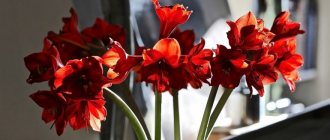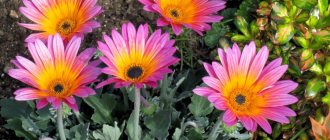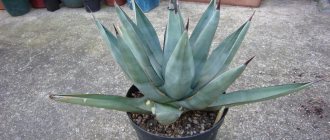Lighting
During growth, the plant prefers bright, diffused light; in summer, direct rays of the sun are allowed only from 11:00 to 15:00.
For normal development, amaryllis requires 16 hours of daylight . During the dormant period, amaryllis bulbs do not need light.
The best place for the plant will be windows facing southwest and southeast. On a south window, the amaryllis will have to be shaded from the midday sun.
During the growth of the peduncle and leaves, the plant must be constantly rotated so that the peduncle does not bend.
Can it be grown in the garden?
To successfully grow amaryllis in the garden, the following rules should be followed:
- Choose a suitable location on the site and planting material. The bulb must be healthy and without any damage, its roots must be well developed.
- Before planting, you need to remove the scales from it and treat it with a disinfectant, this can be a weak solution of potassium permanganate or fungicides. You need to soak the onion for thirty minutes, then leave it to dry for one day. Once the bulb has dried, you can begin planting.
- To grow a flower in open ground, it is recommended to choose a sunny area. This may be located on the south side or in a windless place.
- During flowering, you should pay more attention to the soil and its moisture; if necessary, it is recommended to feed the plant.
- The soil must be fertile and moisture-permeable. If these requirements are not met, it is recommended to treat the selected area with organic mineral fertilizers and loosen the soil.
- The period of planting in open ground is May - June. When planting, you need to take into account the distance between flowers; it should not be less than 10-15 centimeters from each other. To straighten the roots of the flower you need to make spacious and deep holes. After the roots have been straightened, cover the planting material with soil.
- Monitor the plant carefully, as in open ground it can encounter various diseases and pests.
- After the bulb has been planted, water the flower sparingly. When the shoot grows to 10-12 centimeters, water treatments increase; during this period the flower needs more moisture.
If planting rules are followed, amaryllis will bloom in late August or early September.
Temperature
Temperature conditions during active growth:
- Daytime 20–22° C;
- At night no less than 18° C.
During the dormant period, amaryllis bulbs should be kept in a cool place . The optimal temperature will be about 15° C, the minimum 10° C, and the maximum 18° C. At low temperatures, the bulb may die, and at high temperatures, it may germinate too quickly, not allowing the plant to fully rest.
In summer, it is not advisable to take the flower out of the room, since differences in day and night temperatures in the middle zone can be significant. This plant does not like sudden decreases or increases in temperature, which can lead to a lack of flowering.
This flower requires a period of rest. But it is not always possible to keep a flower in a cold room. In order for amaryllis to successfully overwinter and produce a peduncle in the spring, it can be kept at room temperature 20-22ºС, but in relative dryness. In this case, the flower will not grow in winter.
In a state of rest
The rest period is 4 months. This is the optimal value for normal development and flowering. In this case, the following care features are observed:
- Amaryllis care at home after flowering does not require much time. You need to choose a place where there is no direct sunlight. At the same time, you should not remove all the leaves so that the beneficial substances from them get into the bulb.
- After the flower has begun to fade, experts recommend waiting for the peduncle to dry and, taking out the bulb, separate the young children from it, treat the existing wounds and remove the dried roots. Then you can plant it again in the same pot or store it in a cool place.
- To protect seed material from pests and diseases, it is treated with a weak solution of potassium permanganate.
- When storing without soil, a preventive inspection is carried out every week to promptly identify lesions or prevent the bulbs from drying out.
Important! Planting material must be large and healthy
Watering
During flowering, amaryllis needs abundant watering - the soil should be moist, but not waterlogged. Watering frequency – the top layer of soil should dry out slightly between waterings. Water the plant with settled water at room temperature . It is important that water does not get on the bulbs.
When flowering ends, watering is reduced, and after 2 months it is completely stopped.
During this time, the amaryllis loses its leaves, and a dormant period begins, during which the plant does not need to be watered.
After the end of the dormant period, when the peduncle reaches a height of 10 cm (but not earlier!), switch to the normal watering regime, taking into account the temperature and dryness of the air in the room.
If the air in the room is too dry, you can spray the buds a little . It is strictly forbidden to spray flowers, leaves, and bulbs during the dormant period.
How to replant a plant
The bushes can be pruned after flowering or simply remove faded inflorescences. Carefully remove the flower from the pot. The earthen lump is usually dense and penetrated by many roots. Traces of dead tissue are visible on some fragments. Therefore, at the time of transplanting an indoor azalea, treatment must be carried out. It includes:
- removal of old substrate;
- root pruning;
- treatment with growth stimulator and zircon.
Due to the high density of the root system inside the pot, the azalea does not receive enough nutrients. To correct the situation, the earthen ball is cut off from below by about a centimeter - along the side surface and at the root collar, while simultaneously removing the remaining soil.
At the next stage of transplanting an azalea after purchase, it is lowered into a container filled with clean warm water. During the preparation of the soil mixture, the azalea roots will be thoroughly saturated with moisture. The soil for the plant should be loose and airy, the container should not be deep, the main thing is that there is enough space for an impressive layer of drainage.
The soil for the plant should be loose and airy, the container should not be deep, the main thing is that there is enough space for an impressive layer of drainage.
The treated and moisture-soaked bush is placed in the prepared soil. After transplantation, it should be sent to a well-lit place where there is no direct sunlight, drafts or heating devices. In the first three to four days, the soil is not moistened, then watering is gradually resumed using settled or filtered water at room temperature. Within one to two months, the plant undergoes acclimatization and compensates for the loss of the root system. If the flower does not need to be divided into several bushes, it is replanted using the transshipment method.
The soil
For amaryllis, a soil consisting of turf soil (2 parts), peat (1 part), humus (1 part) and sand (1 part) is suitable. The soil acidity indicator should be pH 6.0–6.5.
You can also use a different soil composition for planting this plant. Here are its ingredients:
- Sod land - 2 parts;
- Leaf soil - 2 parts;
- Humus – 1 part;
- Peat – 1 part;
- Washed river sand – 1 part.
Sand can be replaced with leavening agents such as perlite or vermiculite. The specified soil composition will ensure the outflow of excess water into the pan during watering.
Also, to prevent water from stagnating in the soil, a drainage layer is placed at the bottom of the pot. Good drainage is essential to prevent root and bulb rot.
Light and loose soil, slightly acidic or neutral acidity, is suitable for amaryllis. Such soil mixtures for decorative flowering bulbous plants are always on sale. They are easiest to purchase at flower shops or garden centers.
Diseases, pests and treatment methods for amaryllis
There are a number of diseases that weaken the flower and spoil its appearance. The most common among them are:
- Anthracnose. This fungal disease is characterized by the appearance of brown spots and streaks on the leaves and their tips. Most often, the cause of anthracnose is excessive watering of the soil and spraying of the flower. In order to cure a flower, reduce watering, remove damaged leaves and treat the plant with a fungicide.
- Stagonosporosis (red burn). The disease develops with excessive watering, as well as frequent and sudden changes in temperature in the room. The disease is characterized by red spots that appear on the entire surface of the plant, including on the bulb.
If they are detected, it is necessary to immediately isolate the flower to prevent infection of other flowers. To cure the plant, it is necessary to cut off the damaged parts of the surface of the bulb and rotten roots and treat them with a fungicide. For the first time after treatment, watering should be limited.
- Gray rot. The most common cause of its appearance is excess moisture in the soil. This infectious disease manifests itself in brown spots on the leaves of the plant. Isolate the flower and then replant it in fresh soil. Water the flower less often, avoiding liquid stagnation in the ground.
- Root rot. Appears due to lack of nutrients and severe temperature changes. Disinfect the soil with Fundazol and isolate the flower for a while, since the infectious agent can persist in the bulb for a long time.
The main pests that interfere with the full development of amaryllis are onion mites, false scale insects, aphids, mealybugs and thrips. To get rid of pests you need to do the following:
- if you notice that the above-ground part of the soil is rotting, reduce the temperature in the room, as it can provoke the appearance of onion mites;
- if brown spots appear on the leaves due to false scale insects, a solution of laundry soap will help, which should be used to treat the affected plant;
- if the leaves turn yellow due to aphids and thrips, treat the plant with a soap solution or Aktara;
- Wet wiping will help against mealybugs, and in more advanced cases, insecticides.
It will also be interesting: Lily tree - planting and care, varieties, names and descriptions?
Fertilizer
During active growth and flowering, fertilizing is carried out once every 10 days. To do this, use a complex liquid fertilizer suitable for flowering plants.
At the end of flowering, fertilizing is reduced, and after the leaves wither, stop completely . Fertilizer application is resumed only with the appearance of flower stalks from the bulb.
They begin to fertilize the soil for amaryllis when flower stalks appear from the bulb in the spring. Use liquid complex fertilizers for flowering plants or special formulations for bulbous plants.
It is important not to overfeed the plants after the leaves form and flowering ends. This species grows leaves after the formation of a peduncle. The plant is fed only with fertilizers for flowering plants, never using formulations for deciduous varieties. This allows you to maximize flowering and reduce the rate of leaf growth.
Modern varieties
The development of modern amaryllis breeding proceeds mainly in 3 directions:
- improvement or search for new varieties with classic large flowers of double and non-double forms. I would like to mention such double varieties as Celica, Double Roma, Double Dragon, Ice Queen, Pink Nymph, Merry Christmas, Macarena, Promise, etc. Among the non-double monochrome forms, the varieties Black Pearl, Ampulo, Benfica, Exotica, Faro, are very interesting to my taste. Lemon Lime, Moonlight, Matterhorn, Rosalie, White Baby, etc.;
- searching for fundamentally new two- or multi-color colors, or adding new shades to existing ones. I would note such modern varieties as Charisma, Gervesa, Temptatia, Prelude, Misty, Clown, Neon, Estella, Santa Cruz, Papillio, Pizazz, etc.;
- search for new flower forms, for example, the so-called narrow-petalled varieties of amaryllis or “spiders”, from the English “spider” - spider. This group includes varieties Spotty, Santana, Grandeur, Night Star, Chico, Lima, Evergreen, La Paz, etc. All of them look very beautiful in group compositions, but single flowers, in my opinion, are much inferior to large-flowered hybrids.
Peculiarities
For normal development and abundant flowering of amaryllis, special care rules must be followed during the period of growth and dormancy. Amaryllis is also a poisonous plant and should only be handled with gloves.
Do not forget that amaryllis is a poisonous indoor plant. Do not allow juice to come into contact with skin or food. But don’t rush to get rid of the plant - when growing it, you just need to follow precautions.
Periods of growth and rest
Let's look at how to care for amaryllis at home in different phases. At home, amaryllis is grown as a regular houseplant until late autumn. At this time, it is regularly watered and fed.
After amaryllis blooms, you need to remove the flower stalks. There is no need to touch the leaves - they will be a source of nutrients for the bulb.
In order for amaryllis to bloom in winter, the bulbs need to be provided with a period of rest . To do this, from August you need to reduce watering and stop fertilizing. After three weeks, watering should also be stopped. The leaves should turn yellow and wither on their own, after which they need to be cut to a height of 5 cm from the bulb.
In September and early October, the bulbs are planted in a pot and stored in a dark, dry and cool (13–15° C) place. The dormant period will begin when there are no green leaves left on the plant and will last 6-8 weeks.
Around November, the pot with the plant is placed in a lighted place and begins to be watered regularly. From this point on, the period of growth begins again.
Before and after flowering, keep the soil moist and rotate the plant constantly to promote even growth. During this period, the optimal temperature will be 13–18° C. 4–8 weeks after watering is resumed, the amaryllis should bloom.
Amaryllis blooming
The flowering period of amaryllis occurs in late autumn or early winter. A flowering plant throws out a powerful peduncle, at the end of which there is an inflorescence. Usually during flowering the plant has no leaves. Sometimes 1 pair of leaves grows along with the peduncle.
With optimal care, amaryllis blooms once a year. However, you can get flowers twice a year without damaging the plant. Adult specimens with a bulb diameter of at least 5 cm are suitable for this. They will bloom in the summer, subject to regular feeding in the spring.
To induce natural flowering of amaryllis in the summer, you need to create an additional dormant period for it. To do this, you need to move it from a lighted place to a shaded place, away from the window.
Watering is reduced by 2-3 weeks. After a 2-week stay in the shade, its leaves gradually die off, and a peduncle grows from the top of the bulb.
After the formation of a peduncle, the plant begins to be watered as usual. Now it can be transferred to the windowsill, where it will soon bloom.
How to plant Amaryllis in a pot
To plant this color, bulbs are used, which are quite simple to use. Amaryllis germinates easily, so even a novice gardener can acquire such a beautiful plant. So, when planting it is worth considering a lot of nuances:
- You definitely need to pay attention to the quality of the bulbs themselves. All the same requirements can be applied to them as to regular onions - they must be hard, fairly heavy, dense to the touch and dry. Do not use limp specimens with stains or damage;
- if you have purchased bulbs, but do not yet have the opportunity or desire to plant them, then you can leave them for a while in a dark, dry and cool place - this way they will not take root (the refrigerator is not suitable for this purpose);
- Separate attention should be paid to the choice of pot. The plant is quite tall, so you need a stable, heavy pot, the diameter of which should be 10 centimeters larger than the diameter of the bulb itself. To obtain the greatest decorativeness of the plant, place 2-3 bulbs in one pot, increasing its diameter by another 5 centimeters in this situation. Drainage holes are a must;
- The soil for the flower should be well permeable to air and water. The pot is filled with slightly damp soil about halfway, then an onion is placed in the center and more earth is added so that a third of the onion remains uncovered at the top. The soil around is lightly crushed and, if necessary, watered a little.
Until the flower takes root and begins to sprout, it does not require abundant watering, especially since you should not wet the top of the bulb itself.
About two months after planting, with proper care, Amaryllis will begin to bloom and delight with its beauty.
Diseases
Amaryllis can be affected by fungal infections, such as gray mold. Signs of infection: brown spots or stripes on flowers, stems or bulbs, or a grayish velvety coating on the leaves.
As a rule, the disease is caused by too humid air and waterlogging of the soil.
The causative agents of this disease live in the soil, so the diseased plant must be replanted. In addition, they are treated with special preparations - fungicides.
The plant can become infected with thrips or aphids . Signs: leaves turn yellow and become deformed.
Small reddish spots may appear when infested with mites. Treatment with insecticides, which must be carried out several times, will help in pest control.
Rules for purchasing in the store
If you decide to buy an adult plant for your home collection, then it is better to purchase it during flowering. This way you can avoid making a mistake with the color and buy the flower you like best. The plant must be healthy and strong, without signs of disease, rot or spots on the leaves.
Purchasing bulbs for growing
It is advisable to buy bulbs in autumn or spring. When choosing, you should pay attention to their appearance. There should be no dry, soft or rotten areas on the bulbs.
Read here which plant varieties are best suited for indoor growing.
Problems
- The flowers are turning pale . Reason: direct sunlight;
- The flowers darken or even turn black. Reason: damp air and low room temperature;
- The leaves become pale and the flowers droop. Reason: insufficient watering;
- The leaves are turning yellow . Causes: damage by thrips or aphids, waterlogging of the soil;
- The bulbs are getting smaller. Reasons: a large number of children, lack of lighting, abundant flowering;
- The plant does not bloom . Reasons: improper care, too short or no rest period, deep planting of the bulb, damage to the root system. The bulb will not have enough strength to release a peduncle if there is a lack of heat, light, fertile soil, drainage and sufficient watering. During the dormant period, the bulb accumulates strength for flowering.
How to grow amaryllis at home?
In order for an amaryllis flower to take root well in our climatic conditions, it needs appropriate conditions - for example, a warm sunny place, but without direct sunlight. The flower does not like drafts, so you will also have to take care of this in advance.
Before you grow an amaryllis flower at home, you will have to be patient. It throws out the first flower stalks only 3 years after planting at its permanent “place of residence.” For planting, use not wide pots, the walls of which are only 4 - 5 cm wider than the diameter of the amaryllis planting bulb.
The correct choice of variety and bulbs for planting is of great importance. They should be clean, dry, with a small fibrous root system. All bulbs damaged by rot or blackness should first be disinfected. To do this, you can use wood ash, fluffed lime or magnesia. The bulbs are first soaked for 2 hours in a weak solution of potassium permanganate. After this, it is immediately completely dipped in ash or lime and left on paper until completely dry.
Reproduction
Amaryllis can be propagated by pups separated from the mother bulb and by seeds. Before transplanting amaryllis, you need to choose the appropriate method.
Branch of daughter bulbs
This is the simplest and most common method. The grown children are separated from the mother plant during spring transplantation .
First, they are grown in small containers with a sand-perlite mixture or sphagnum, and then transplanted.
In this case, the composition of the soil, the height of planting the bulb, and the capacity of the pot should be the same as when transplanting an adult plant. Young bulbs grow quickly and bloom within 2–3 years.
Amaryllis from seeds at home
Growing amaryllis at home is a rather long, labor-intensive and unreliable method. To obtain seeds, pollen is transferred from one plant to another with a brush. Amaryllis seeds ripen for about a month, after which they are planted in the soil and watered abundantly.
Shoots should appear in a month. Grown young plants are planted one at a time in separate small pots. Amaryllis grown from seeds bloom only in the 7th year.
Amaryllis: its morphological description
Homeland - Karoo desert (South Africa). In October, the deserts begin to experience scorching heat. Therefore, amaryllis hide in dry, hot soil. A lump of juicy tender leaves and flower primordia is covered with a dense skin. The stem dies, the roots dry out, but the bulb lives. After the rains, it quickly germinates and blooms.
Amaryllis is the name of a beautiful shepherdess described in the idylls of the ancient Greek poet Theocritus. The plant blooms in spring and autumn (amparyllis is powerful and striped). From the bulb grows an arrow 0.5 m tall, with an umbrella of 4-5 white, red, pink, lily-like flowers. They sit on a round peduncle. At the same time, long dark green leaves appear. In our conditions, they develop during winter and spring and dry out by summer. You should not cut off wilted leaves, as organic matter from them goes into the bulb.
The widespread bulbous plants grown under the name amaryllis are actually members of two different genera (hippeastrum and amaryllis) or hybrids of both.
Amaryllis photo
From the genus amaryllis, Amaryllis belladonna and different varieties of large-flowered amaryllis of hybrid origin obtained as a result of crossing are grown at home. Their flowers reach 18-20 cm in diameter and consist of 6 petals. Stamens of equal length with petals, style with 3-lobed stigma. The bulbs are large (5-7 cm), pear-shaped. After flowering, they lose their leaves and go into a dormant state, but the bulbs retain living roots, so they need to be watered occasionally.
Transfer
Amaryllis is a perennial plant, so there is no need to replant it every year. It will be enough just to replace the top layer of soil. This must be done very carefully so as not to damage the root system. In addition, the bulb cannot be buried above the previous soil level.
Usually amaryllis are replanted every 2–4 years , or when it is necessary to separate the children from the mother bulb for propagation.
The best time to transplant amaryllis at home is 3-5 weeks after flowering has ended.
This is explained by the fact that the bulb greatly decreases in size during flowering due to the consumption of nutrients contained in it.
When replanting, select a pot with a diameter equal to the bulb plus 1.5–2.0 cm on all sides - in cramped containers, amaryllis begin to bloom faster and more abundantly.
Dried and withered outer scales are removed from faded amaryllis, and bad roots are removed from the bulb and the children with roots are separated.
If the bulb has no roots at all, it can still be replanted - the roots will grow in 4-6 weeks. A drainage layer is placed on the bottom - expanded clay, broken shards, gravel, and it is advisable to pour a little sand under the bulb. The soil is taken of the same composition (see above). The bulb is buried in the ground half or 2/3 of its height.
Botanical description
Amaryllis (Amaryllis) is a bulbous plant of the amaryllis family, characterized by large umbrella-shaped inflorescences and elongated basal leaves.
Up to 6-12 flowers bloom on one plant, and the length of the leaves can reach 60 cm. In nature, amaryllis can be found in Australia, as well as in southern Africa.
The color of the flowers depends on the variety, as well as the flowering period. Most species begin to bloom in late April or May, followed by a dormant period in the second half of autumn. With proper care, you can achieve year-round flowering at home.
At the end of flowering, fruits appear, which are a triangular box with seeds. However, in indoor conditions the plant rarely bears fruit.
Expert opinion Vera Ivanovna Sh Since childhood, she was fond of growing indoor flowers, then she decided to devote her life to landscape design and gardening.
Amaryllis is a poisonous plant, so keep the pot away from children and animals to avoid poisoning.
Description of the plant and species
Amaryllis is a bulbous flowering plant native to South Africa. It has a large pear-shaped bulb, the diameter of which can reach 10 cm.
The leaves of the plant are narrow and long, reaching 30 cm in length. Amaryllis blooms in late autumn or early winter. The flowers are large, there are up to 12 of them on one peduncle. The peduncle of the plant is long, up to 40 cm, juicy and fleshy.
Until recently, the Amaryllis belladonna species was considered the only one of its kind. Today, another species of this genus has been found - Amaryllis Paradisicola.
Amaryllis belladonna is a very popular plant in indoor floriculture. Thanks to its compact size and amazingly beautiful flowers, this species is common in the collections of flowering plant lovers almost everywhere. Wild flowers have pink, red and even purple tints.
This species gave rise to many varieties, distinguished by unusual coloring, flower size and petal shape. There are large-flowered, variegated and narrow-petaled varieties. Here are some popular amaryllis varieties:
- “Exotica” is a large-flowered variety;
- "Minerva" - a variety with variegated striped petals;
- "Exotic Star" is a narrow-petalled variety.
Amaryllis Paradisicola differs from the previous species in the large number of flowers in the inflorescence. There can be up to 21 of them. All flowers of the species have a uniform pink tint and a pleasant aroma. Not common in indoor floriculture.
Additional tips and tricks
Inexperienced gardeners will benefit from advice from experienced amaryllis lovers:
- The large diameter of the pot and excess free space stimulate the bulb to reproduce. She gives birth to children, there is no energy left for flowering.
- Do not bury the bulb - this interferes with the growth of the peduncle.
- If it is not possible to provide natural light, the flower is illuminated with fluorescent lamps.
- Active fertilizing supports the growth of the peduncle and provides a large number of buds.
- Without rest in a dark, cool place, the bulb will not gain strength for new flowering.
- Bulbs damaged by pests and disease must be completely cured before planting.
- When transplanting and cleaning the bulbs, you should use gloves - the tissues contain poison that is dangerous to humans.
- If there are a large number of amaryllis, you need to provide convenient racks for winter storage in optimal conditions.
If the bulb is growing too quickly, you should not wait 3 years to transfer to a larger container. The plant should be replanted earlier to provide comfortable conditions for the growing season.
All the difficulties of caring for amaryllis pay off with beautiful flowers standing proudly on a dense long stem. Breeders have created real masterpieces - bright, lush, exquisitely shaped and shaded hybrids that decorate apartments not only with their appearance, but also with a pleasant aroma. With proper care, amaryllis will delight you with abundant flowering for many years.
Share link:
Plant care
Watering and fertilizing
Amaryllis should be watered sparingly during its growth phase.
Watering begins when the peduncle grows to 10 cm in height. The plant loves moisture, but categorically does not tolerate stagnation of water. It is better to forget about watering than to overdo it. The best option is abundant watering every 3-4 days. Another important point is that water should not fall directly on the bulb. Water only the surrounding soil. Amaryllis is fertilized once every 12–14 days, starting from the moment the buds form. During flowering, the interval between fertilizing is reduced to 5–7 days. Any fertilizer for flowering indoor plants is suitable - Emerald, BIO VITA, Bona Forte, Kemira Lux, Ideal, Agricola, Ava, Living World, Rainbow, Reasil, Florist, Bud, Master Color, Power of Life. Give preference to those products that contain more phosphorus and potassium than nitrogen.
You can also use natural organic fertilizers - a solution of fresh manure (1.5 cups per 10 liters of water) or bird droppings (1/3 cup per 10 liters).
Stop feeding when the leaves completely wither. When at rest, the plant is not fed.
Caring for amaryllis - video
https://youtube.com/watch?v=tauUbEddn9A
Flowering period
In nature, amaryllis blooms in late summer or early autumn. But you can make sure that the flowers appear by a certain point; to do this, you need to change the time of planting the bulbs. If they are healthy and well developed, intensive growth begins immediately after planting. After 7–8 weeks, flower stalks will form. If there are more than two, it is better to cut off the excess ones at the base. Excessive flowering will exhaust the bulb too much.
After the first flower blooms, the peduncle can be safely placed in a vase. If you change the water in it daily, the flowers will last 16–20 days. The uncut peduncle blooms for about the same amount of time, but in the first case the bulb is depleted much less. The flowering period will be maximum if both the vase and the pot are placed in a cool place, protected from sunlight.
How to make amaryllis bloom
Only proper care of the plant will allow you to enjoy its beautiful flowers.
Why doesn't amaryllis bloom? Most often for one of the following reasons:
- The pot is too spacious. The onion spends all its energy on the education of its “children.” Therefore, she rightly believes that there is no need to reproduce by seeds.
- The bulb is buried too deep in the ground. This prevents the normal development of the peduncle.
- Lack of nutrients. The bulb is greatly depleted during flowering. If you have not accumulated enough necessary microelements during the previous growth phase, do not expect flowers.
- Lack of lighting and heat. Amaryllis is extremely heat- and light-loving. This is logical, considering where his homeland is. Fluorescent lamps can partially overcome the problem.
- Many roots have rotted or dried out. In this case, the root system is not able to provide the bulb with proper nutrition, even if the necessary substances are present in the soil.
- Missed rest period. After the flowers and peduncle dried out, the plant was not allowed to rest.
- The bulbs are too young. Do not expect that only the transplanted children will immediately begin to bloom. This will happen in 3–4 years. And if you planted seeds, flowers will appear in 7–8 years.
- Bulb damage by pests.
Having determined which negative factor is interfering with your plant, eliminate it.
Dormant period - how to “wake up” a plant after wintering
The dormant period begins only after the last leaf turns yellow and lasts at least 8–10 weeks. It is better to let the plants rest for about three months.
- When the flowers begin to fade, reduce watering and fertilizing. By the time the peduncle dries completely (at the end of October or beginning of November), they are reduced to zero.
- Dried leaves are removed. But you shouldn’t forcefully cut off the entire “crown” - the nutrients from the leaves will go into the bulb.
- Then the pot is placed in a cool, dry, dark place. Since the roots are preserved, the soil is sprayed with water from a spray bottle once every 1.5 weeks.
A less common option is to dig up the bulbs, clean them and store them in cardboard boxes or wooden boxes. In this case, there is a risk of drying out the roots.
Using a little trick, you can make amaryllis bloom twice a year - on time, and also at the end of winter or at the beginning of spring
But it is important to maintain a dormant period so that the bulb accumulates enough strength for future flowering. Give her a rest until at least the beginning of January.
About 2.5 months before the desired date, remove the pots with bulbs that are in the dormant period, move them to a bright and warm room and water a little. Keep the soil slightly moist. This is enough for the active growth phase to begin.
Planting stages:
- We clean the bulbs from excess and bad scales. Next, we process it in a pink solution of manganese: immerse the tubers in the solution for half an hour. Potassium permanganate can be replaced with a fungicide;
- We dry the seed material for 24 hours. If damage is found on the surface, they should be treated with Maxim, Fitosporin or brilliant green, and also dried;
- Half of the planting container is filled with pre-prepared soil;
- Place the bulb with the wide part towards the soil, and add soil until 2/3 of the bulb remains above the surface;
- Press the substrate tightly. You can mulch with small pebbles. We place the pot in a permanent habitat and water it with warm water.
How to distinguish hippeastrum from amaryllis
The main difference between these plants is the structure of the stem. These flowers are united by only one family - amaryllis.
The stem of amaryllis is a dense and uniform crimson shade measuring 40-60 cm. It is capable of holding a large number, from 6 to 12 pieces, of beautiful and fragrant inflorescences up to 8 cm in size. The flowering period begins at the end of summer, and at this time it does not have leaves. It can be planted in open ground in the summer, preferably on the south side. The shade of inflorescences in the wild can be white or red, all shades of pink. The bulb is shaped like a pear.
And at the hippeastrum
a hollow green arrow with a grayish-brown tone, which forms up to 6 flowers 12-15 cm in size that do not emit a scent. It reaches a height of 60-70 cm. Flowering occurs at the end of winter. It has only one, belt-like leaf, which grows back during flowering. This flower is grown exclusively at home. The colors of wild hippeastrum are very diverse: green, purple, orange, white, pink, red and combinations of these tones. The bulb is elongated in shape, can be round, slightly flattened.
Wintering
At the end of August - beginning of September, they stop feeding the flower and reduce the frequency of watering. At the end of October - beginning of November, watering is excluded. From this moment the leaves begin to fall, and by the end of the season the stems are completely bare.
It is not recommended to artificially remove the leaves, since during the process of dying, all the organic substances contained in them are transferred to the bulb. Thanks to this, the nutritional reserve necessary for future flowering is created. If 2-3 leaves remain for a long time, they can be carefully cut off at the base of the bulb or bent down.
During the dormant period, amaryllis in open ground should be watered once every 15-20 days. Containers with bulbs are stored in a cool, dry (5-12 degrees) place (pantry, greenhouse, garage, winter garden). The flower does not require lighting when at rest. The bulbs are left in this form for 8-9 weeks.
Important! Planting material does not tolerate low temperatures. Even a short-term cold spell can negatively affect the condition of the bulbs
Preparations for wintering
Reproduction, planting and replanting of amaryllis flowers
There are several ways to propagate amaryllis. Among them:
- Vegetative propagation (includes dividing the bulb and separating the children).
- Propagation by seeds.
The first method will require some skill
For propagation, it is important to choose a strong bulb. Without digging it out of the ground, cut off its top - the neck and leaves
Then the onion needs to be cut into four equal parts with a vertical cut.
Amaryllis propagation
However, depending on the size of the bulb, the number of parts can be up to eight. It is necessary to insert knitting needles between the lobes, and treat the cut areas with crushed activated carbon. Subsequent maintenance conditions should include watering as the top layer of soil dries, diffused light and a temperature of up to 28˚C.
Amaryllis can be propagated by seeds after collecting them. When the seed capsule begins to crack, up to 80 seeds can be removed from it. There is no need to dry the seeds after collecting, because this can greatly affect their germination. Sow the seeds in a moist soil mixture and maintain regular watering. For successful seed germination, the air temperature must be at least 25˚C.
When the seedlings form two leaves, they can be transplanted into separate containers.
To plant the bulbs, you need to prepare a pot, gardening tools and warm, settled water for watering. The pot must be larger than the diameter of the bulb in order for the plant to take root well. When choosing soil for a bulb, you should give preference to light and nutritious soil. You need to fill the pot with soil, make a hole in it and place the onion there, leaving its top on the surface.
The soil around the bulb must be moistened and watering continued as the soil dries.
As for replanting, amaryllis can be replanted either annually to encourage lush flowering or every few years. Replanting may be necessary if there are a large number of children or if there is no flowering for a long time. Following these rules will help you replant the plant carefully:
- The flowerpot should be spacious, but the distance between its edges and the bulb should not be more than 3 cm.
- The top of the bulb should not be covered with soil.
- The composition of the soil should include: turf and leaf soil, sand and humus.
- Before transplanting, sterilize the soil.











